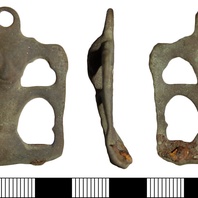
Viking Objects
Stirrup-Strap Mount (BH-D273BF)
This copper-alloy stirrup strap mount is classed as a Williams Class B Type 2 and is decorated with an openwork zoomorphic design.
Read More
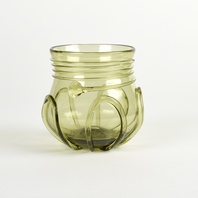
Viking Objects
Reproduction Drinking Glass
A green glass drinking vessel based on one found at Birka and similar to fragments found at St Peter’s Street, Northampton.
Read More
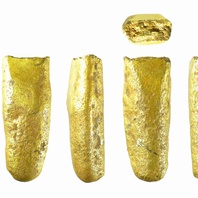
Viking Objects
Gold Ingot (BH-720251)
The Vikings arriving in England had a bullion economy in which they paid for goods, most commonly, with silver that was weighed to an amount agreed between the buyer and the seller. Though rarer than silver equivalents, this gold ingot formed part of the bullion currency used by Vikings in England. It took some time for the Scandinavian settlers to adopt a monetary economy like that of the Anglo-Saxons, and both systems were used simultaneously for a while before they fully adopted the new system. The Vikings were familiar with monetary economies but they treated coins as just another form of bullion before adoption of a monetary economy.
Read More
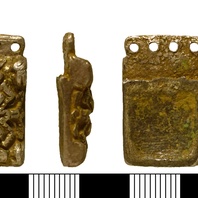
Viking Objects
Carolingian Style Strap-End (NARC-10F5B2)
This silver strap-end is decorated with foliate design cast in relief and is categorized as Thomas (2003) Class E, Type 5 (Carolingian). Carolingian belt fittings from England could have been imported either indirectly through Scandinavia or directly from the Continent. It is possible that this strap end was brought over by Scandinavians after their raids on the continent.
Read More
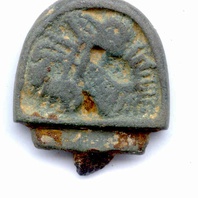
Viking Objects
Possible Knife End-Cap (NARC-D16C22)
A cast copper alloy object with Anglo-Scandinavian zoomorphic decoration resembling an end-cap from a knife or dagger handle. It has been suggested that the decoration is, in fact, Viking Jelling-style decoration from the tenth century.
Read More
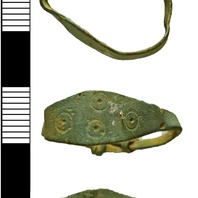
Viking Objects
Stamped Finger-Ring (NARC-031C88)
A stamped copper-alloy finger ring decorated with four double ring-and-dots in a lozengiform arrangement. Ring-and-dot was a decorative technique used at various periods from the later Iron Age onwards, but which enjoyed a Viking Age revival. Rings like this with knotted ends are typically Scandinavian.
Read More
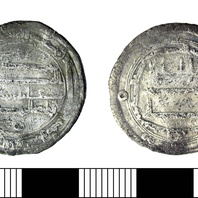
Viking Objects
Silver Dirham (DENO-07CCA4)
A complete silver dirham of Madinat al-Salam (Baghdad) reign of al-Mahdi Billah, 163 AH (780 AD). The dirham was a unit of weight used across North Africa, the Middle East, and Persia, with varying values which also referred to the type of coins used in the Middle East during the Viking Age. These coins were extremely prized possessions not only for their silver value but as a way of displaying one’s wealth and vast trade connections. Millions of Arabic dirhams would have been imported throughout the Viking world and are mostly found in hoards.
Read More
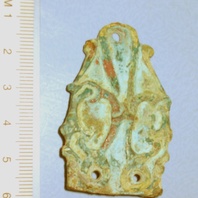
Viking Objects
Stirrup Strap Mount (NARC-C34373)
This cast copper-alloy stirrup strap mount is decorated with Ringerike style ornamentation and is classed under Williams Class A Type 1.
Read More
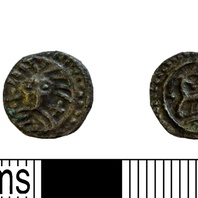
Viking Objects
Danish Silver Sceat (NARC-70AFF4)
This silver sceat is classified as part of the Danish Series X Type 31. The obverse depicts the head of Woden with crosses to either side of a rounded beard and pellet above. The reverse depicts a monster facing left. These coins are considered to be associated with the early trading center at Ribe. It is very likely that they made their way to England by means of Vikings.
Read More
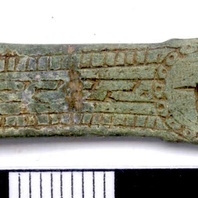
Viking Objects
Irish Strap-End (NARC-3835F4)
This Irish type strap-end is classed as Thomas Class F. The decoration consists of a zoomorphic terminal and panels of interlace. Its manufacture is possibly traced to Viking Age Dublin and is likely linked to Viking distribution of Irish artefacts. Strap-ends came in various styles and were fairly common throughout the Viking world. They were used to decorate the ends of belts and to stop them getting damaged.
Read More
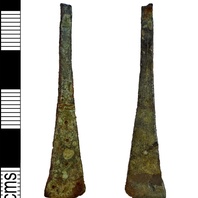
Viking Objects
Copper-Alloy Tweezers (NARC-444DBA)
Tweezers were common personal items that people would have carried with them and could have been highly decorated.
